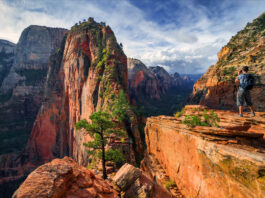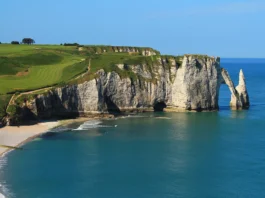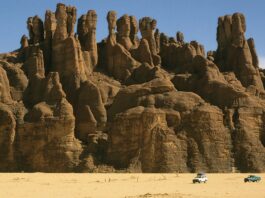Dinosaur Ridge is a world-renowned paleontological and geological site located near Morrison, Colorado, in the United States. It is a place of great significance in the fields of both paleontology and geology, offering a unique window into Earth’s ancient history.


Location and Geological Context: Dinosaur Ridge is situated in the Morrison Fossil Area National Natural Landmark, which is part of the larger Morrison Formation. The Morrison Formation is a geologic formation that dates back to the Late Jurassic period, approximately 148 to 155 million years ago. This formation is famous for its rich assemblage of fossils and unique rock layers that provide valuable insights into the prehistoric world.
Dinosaur Ridge itself is a long, winding ridge that extends for about two miles along the eastern foothills of the Rocky Mountains, offering stunning views of the surrounding landscape. The ridge is primarily composed of sandstone and mudstone layers, which were deposited in ancient environments ranging from riverbanks and floodplains to lakes and swamps during the Late Jurassic period.
Significance in Paleontology: Dinosaur Ridge is celebrated for its exceptional fossil discoveries, which include a diverse array of dinosaur tracks and fossils from the Late Jurassic era. Some of the key paleontological features and findings at Dinosaur Ridge include:
- Dinosaur Tracks: The site is renowned for its well-preserved dinosaur footprints, which provide valuable information about the behavior and locomotion of various dinosaur species. These tracks are found on exposed rock surfaces and include imprints of both herbivorous and carnivorous dinosaurs.
- Fossilized Bones: In addition to tracks, numerous dinosaur bones and skeletons have been discovered in the Morrison Formation at Dinosaur Ridge. These fossils have helped scientists understand the types of dinosaurs that lived in the region during the Late Jurassic.
- Plant Fossils: Dinosaur Ridge also contains fossilized plants and ancient flora, offering insights into the plant life that coexisted with dinosaurs in this ancient ecosystem.

Significance in Geology: From a geological perspective, Dinosaur Ridge is significant for several reasons:
- Stratigraphy: The exposed rock layers at Dinosaur Ridge showcase the stratigraphy of the Morrison Formation, allowing geologists to study the deposition processes and sedimentary history of the region during the Late Jurassic.
- Fossilization Processes: The site provides opportunities to study the processes of fossilization, including how tracks and bones became preserved over millions of years.
- Educational Value: Dinosaur Ridge serves as an important educational resource, offering visitors a chance to learn about Earth’s geological history and the evolution of life on our planet.
In conclusion, Dinosaur Ridge is a remarkable site that combines paleontological and geological significance. It allows scientists and enthusiasts alike to explore the ancient world of dinosaurs and gain a deeper understanding of the Earth’s geological past during the Late Jurassic period. Moreover, it continues to inspire curiosity and scientific research, making it a cherished location in the study of Earth’s history.
Geological Features

Two of the prominent geological features are the Dakota Hogback and the Morrison Formation.
1. Dakota Hogback: The Dakota Hogback is a distinctive geological feature that extends for miles along the eastern foothills of the Rocky Mountains. It is a prominent ridge made up of tilted and eroded layers of sedimentary rock. Here’s an explanation of its unique characteristics:
- Formation: The Dakota Hogback was formed during the Late Cretaceous period, around 100 million years ago. During this time, the area was covered by a shallow sea, and layers of sandstone, shale, and limestone were deposited over millions of years.
- Tilted Layers: What sets the Dakota Hogback apart is the steep angle at which these sedimentary layers are tilted. This tilting occurred due to geological forces, such as tectonic activity and uplift, which caused the once-horizontal rock layers to be pushed up at an angle.
- Erosion: Over millions of years, erosion by wind, water, and ice has exposed these tilted layers, creating the distinctive hogback ridge that we see today. The erosion-resistant sandstone layers form the prominent ridges, while the softer shale layers erode more easily, creating valleys and slopes.
- Fossils: While the Dakota Hogback itself is not known for its fossil finds, the rock layers within it can contain fossils, particularly in the shale and limestone layers. These fossils can provide valuable information about the ancient marine life that once inhabited the region.
2. Morrison Formation: The Morrison Formation is a well-known geological formation that underlies much of the western United States and is of great significance to paleontology. Here’s a description of the Morrison Formation as it pertains to Dinosaur Ridge:
- Composition: The Morrison Formation is composed primarily of sedimentary rocks, including sandstone, mudstone, limestone, and conglomerates. These rocks were deposited during the Late Jurassic period, approximately 148 to 155 million years ago.
- Ancient Environment: The Morrison Formation was deposited in a variety of environments, including riverbanks, floodplains, lakes, and swamps. This diverse range of environments is reflected in the different rock types and fossils found within the formation.
- Fossils: One of the most significant aspects of the Morrison Formation is its rich fossil record. It contains a wide variety of dinosaur fossils, including both herbivorous and carnivorous species. Some well-known dinosaurs from the Morrison Formation include Allosaurus, Stegosaurus, and Apatosaurus (formerly known as Brontosaurus).
- Dinosaur Ridge: Dinosaur Ridge is a specific location where the Morrison Formation is exposed, and it has yielded numerous dinosaur tracks and fossils. The site is particularly famous for its dinosaur tracks, which offer valuable insights into the behavior and locomotion of these ancient creatures.
In summary, the Dakota Hogback and the Morrison Formation are key geological features of Dinosaur Ridge. The Dakota Hogback is a striking ridge with tilted sedimentary layers, while the Morrison Formation is a fossil-rich geological unit that preserves the remains of dinosaurs from the Late Jurassic period. Together, these features make Dinosaur Ridge a unique and significant site for both geologists and paleontologists.






